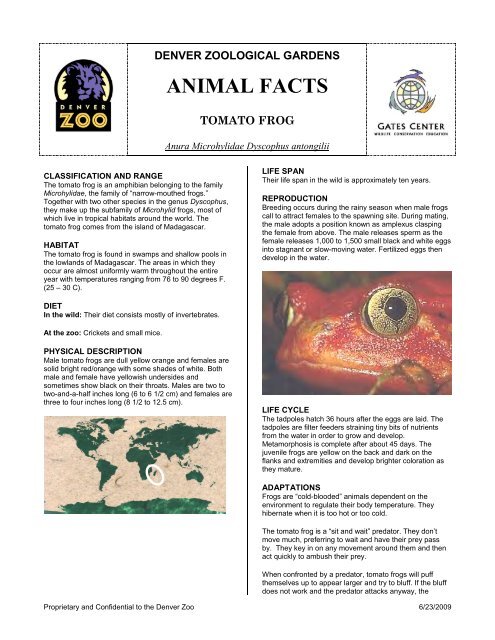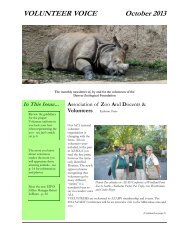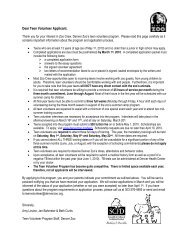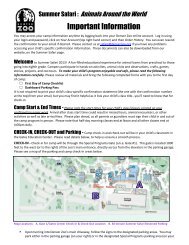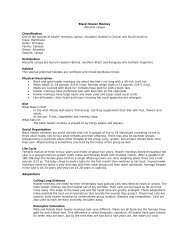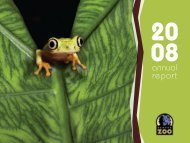ANIMAL FACTS - Denver Zoo
ANIMAL FACTS - Denver Zoo
ANIMAL FACTS - Denver Zoo
You also want an ePaper? Increase the reach of your titles
YUMPU automatically turns print PDFs into web optimized ePapers that Google loves.
DENVER ZOOLOGICAL GARDENS<strong>ANIMAL</strong> <strong>FACTS</strong>TOMATO FROGAnura Microhylidae Dyscophus antongiliiCLASSIFICATION AND RANGEThe tomato frog is an amphibian belonging to the familyMicrohylidae, the family of “narrow-mouthed frogs.”Together with two other species in the genus Dyscophus,they make up the subfamily of Microhylid frogs, most ofwhich live in tropical habitats around the world. Thetomato frog comes from the island of Madagascar.HABITATThe tomato frog is found in swamps and shallow pools inthe lowlands of Madagascar. The areas in which theyoccur are almost uniformly warm throughout the entireyear with temperatures ranging from 76 to 90 degrees F.(25 – 30 C).LIFE SPANTheir life span in the wild is approximately ten years.REPRODUCTIONBreeding occurs during the rainy season when male frogscall to attract females to the spawning site. During mating,the male adopts a position known as amplexus claspingthe female from above. The male releases sperm as thefemale releases 1,000 to 1,500 small black and white eggsinto stagnant or slow-moving water. Fertilized eggs thendevelop in the water.DIETIn the wild: Their diet consists mostly of invertebrates.At the zoo: Crickets and small mice.PHYSICAL DESCRIPTIONMale tomato frogs are dull yellow orange and females aresolid bright red/orange with some shades of white. Bothmale and female have yellowish undersides andsometimes show black on their throats. Males are two totwo-and-a-half inches long (6 to 6 1/2 cm) and females arethree to four inches long (8 1/2 to 12.5 cm).LIFE CYCLEThe tadpoles hatch 36 hours after the eggs are laid. Thetadpoles are filter feeders straining tiny bits of nutrientsfrom the water in order to grow and develop.Metamorphosis is complete after about 45 days. Thejuvenile frogs are yellow on the back and dark on theflanks and extremities and develop brighter coloration asthey mature.ADAPTATIONSFrogs are “cold-blooded” animals dependent on theenvironment to regulate their body temperature. Theyhibernate when it is too hot or too cold.The tomato frog is a “sit and wait” predator. They don’tmove much, preferring to wait and have their prey passby. They key in on any movement around them and thenact quickly to ambush their prey.When confronted by a predator, tomato frogs will puffthemselves up to appear larger and try to bluff. If the bluffdoes not work and the predator attacks anyway, theProprietary and Confidential to the <strong>Denver</strong> <strong>Zoo</strong> 6/23/2009
tomato frog’s skin begins to secrete a thick, whitish toxinthat looks like Elmer’s glue. Interestingly, it also works likeElmer’s glue, gumming up the teeth and then the mouth ofthe attacker.These frogs are nocturnal, hiding from predators duringthe day and hunting for food at night.SOCIAL ORGANIZATIONFrogs are solitary except during breeding season.APPROPRIATE TOURSAnimal Babies/Families, Animal Adaptations, AnimalCoverings, Animal Diversity, Endangered Species,Tropical Discovery, Habitat, Rainforest Discovery, AfricanAnimalsINTERPRETIVE TIPS1. Use a party blower turned upside down to show howthe tongue of a frog works.2. Use your fist or hand to show the size of this frog.3. Use Elmer’s white glue to show the toxin secretion ofthis frog.4. Pour water over a piece of cotton fabric todemonstrate the permeability of frog skin.BIO<strong>FACTS</strong> AVAILABLEFrog life cycle, amphibian set modelsTHINGS TO TALK ABOUTCharacteristics of amphibiansCold-bloodedAnura translates as “without a tail”Loss of habitatHow frogs that cannot extend their tongue grab their preyCONSERVATION CONNECTIONThe Madagascan tomato frog has been listed on AppendixI of CITES. The main reason for its endangered status isthe dramatic deforestation in Madagascar and,unfortunately, the worldwide trade of this species of frog.These primitive vertebrates with their absorbent skin arevery vulnerable to toxic substances such as runoff ofpesticides, herbicides and detergents into the ponds andditches where they often breed.STATUSOne of the three subspecies of tomato frog is listed onAppendix I - CITES - EndangeredSOURCES AND SUGGESTED READING1. The Encyclopedia of Reptiles and Amphibians, Dr.Tim Halliday and Dr. Kraig Adler, Facts on File Inc,New York, NY, 1994.2. Animal Kingdom, Dr. Colin Groves, Sally Reader,Joseph M. Forshaw, Dr. Glen Shea, Dr. Max Moulds,Barnes & Noble3. www.denverzoo.org4. www.chaffeezoo.org5. www.sdgwickzoo.orgEspecially for kids!1. The Frog Alphabet Book, Jerry Pallotta,Charlesbredge Publishing, Watertown, MA.2. Frogs, David Badger, Voyager Press, Inc, Stillwater,MN, 1995.3. www.enchantedlearning.orgFascinating FactsTomato frogs turn brown when they are not happy.Tomato frogs shed their skin and eat it.Frogs are “thermometers” indicating the health of anecosystem. They breathe through their permeableskin so soil, water and air pollution can drasticallyaffect them causing malformations or death.When a frog swallows a meal, his bulgy eyeballs willclose and apply pressure to push the frog’s mealdown its throat.Proprietary and Confidential to the <strong>Denver</strong> <strong>Zoo</strong> 6/23/2009


